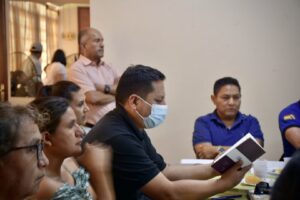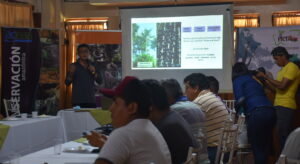Research Finds Chagas Disease in Pando Not Linked to Local Açai
June 30, 2022
 On June 28, at a meeting of the Inter-Institutional Platform for Connection of Amazon Fruit Products (PICFA) in Cobija, Bolivia, we presented a study that corrects misinformation about the link between açai and the parasite causing Chagas disease in the region. While the parasite Trypanosoma cruzi has been found in the primary açai species produced in Brazil (Euterpe olerásea), the açai species grown in Pando (Euterpe precatoria) is distinct. The presentation of this research, which impacts açai producers across the region, shows the importance of disseminating information through the Observatory of Amazonian Fruits and Climate Change to strengthen local information-sharing resources and networks for forest producers.
On June 28, at a meeting of the Inter-Institutional Platform for Connection of Amazon Fruit Products (PICFA) in Cobija, Bolivia, we presented a study that corrects misinformation about the link between açai and the parasite causing Chagas disease in the region. While the parasite Trypanosoma cruzi has been found in the primary açai species produced in Brazil (Euterpe olerásea), the açai species grown in Pando (Euterpe precatoria) is distinct. The presentation of this research, which impacts açai producers across the region, shows the importance of disseminating information through the Observatory of Amazonian Fruits and Climate Change to strengthen local information-sharing resources and networks for forest producers.
According to this study, presented this past month by Daniel Larrea, Coordinator of Science and Technology at Conservación Amazónica – ACEAA in the department of Pando’s capital city, the presence of the parasite Trypanosoma cruzi was not found in any of the local samples studied. These results indicate that the processed product of the local açai species is safe to consume in its initial processing stages. Entitled “Açai and Chagas: Myth or Reality, Molecular detection of the parasite that causes Chagas disease in açai fruit and pulp,” this study also serves as an important tool for early detection measures to control and prevent the spread of diseases like Chagas in the processing of Amazonian fruits in Pando.
this study also serves as an important tool for early detection measures to control and prevent the spread of diseases like Chagas in the processing of Amazonian fruits in Pando.
The technical manual with the study’s results is available in Spanish on the website of the Observatory of Amazonian Fruits and Climate Change here. Daniel Larrea also gave an interview discussing these important findings, which can be viewed in Spanish here.
To find out more about how we are working to build local networks to support local forest producers and their livelihoods in Pando through the Observatory of Amazonian Fruits and Climate Change, take a look at our latest update or visit the Observatory’s website here.
This study was part of the project, “Strengthening of sustainable productive capacities in communities of the Manuripi National Amazon Wildlife Reserve in Pando, Bolivia,” implemented by our partners in Bolivia, Conservación Amazónica-ACEAA, in collaboration with SWEBOL BIOTECH A.B. S.R.L. with financial support from the World Wildlife Fund and Andes Amazon Fund (AAF), through the Inter-Institutional Platform for Connection of Amazon Fruit Products (PICFA) of Pando in coordination with the Departamental Federation of Açai and Amazonian Fruit Harvesters of Pando (FEDAFAP).

